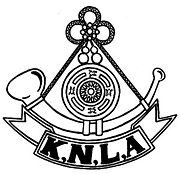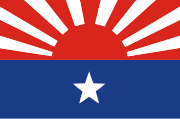
Karen National Liberation Army
Encyclopedia


Karen National Union
The Karen National Union is a political organisation with an armed wing, the Karen National Liberation Army that represents the Karen people of Burma. It operates in Eastern Burma, and has underground networks in other areas of Burma where Karen people live. In Karen, this Karen area is called...
(KNU), which campaigns for the self-determination of the Karen people
Karen people
The Karen or Kayin people , are a Sino-Tibetan language speaking ethnic group which resides primarily in southern and southeastern Burma . The Karen make up approximately 7 percent of the total Burmese population of approximately 50 million people...
of Burma. The KNLA has been fighting the Burmese government since 1949.
The KNLA may have had a strength of roughly 5,000 soldiers in 2006. It is nominally divided into seven brigades and a 'Special Force'.
History
At the time of Burma's independence from the BritishUnited Kingdom
The United Kingdom of Great Britain and Northern IrelandIn the United Kingdom and Dependencies, other languages have been officially recognised as legitimate autochthonous languages under the European Charter for Regional or Minority Languages...
in 1948, there was considerable tension between the Karen
Karen people
The Karen or Kayin people , are a Sino-Tibetan language speaking ethnic group which resides primarily in southern and southeastern Burma . The Karen make up approximately 7 percent of the total Burmese population of approximately 50 million people...
community and the Burmese majority. Some Karens sought independence while others attempted co-existence within Burma. The KNLA was previously called the Karen National Defence Organisation (KNDO). The KNDO was an armed organisation which was formed by the KNU in 1947 to defend Karen communities and interests. Most KNDO soldiers had previously served in the forces of British Burma.
In early 1949, portions of a socialist political militia raised by the government went on a rampage in Karen civilian areas. The Burmese government then arrested the Karen leader of the armed forces and replaced him with radical Burmese anti-Karen nationalist Ne Win
Ne Win
Ne Win was Burmese a politician and military commander. He was Prime Minister of Burma from 1958 to 1960 and 1962 to 1974 and also head of state from 1962 to 1981...
. Continued attacks against Karen dominated townships around Rangoon and the arrest of Karen political leaders led the Karen national Union to declare armed struggle, and the world's longest running civil war began.
Early in the fighting, Karen forces overran much of Northern Burma including towns such as Mandalay
Mandalay
Mandalay is the second-largest city and the last royal capital of Burma. Located north of Yangon on the east bank of the Irrawaddy River, the city has a population of one million, and is the capital of Mandalay Region ....
and established strong positions outside Rangoon at Insein Township. But lacking a port from which to receive military supplies, the Karen forces gradually withdrew to the southeast of Burma.
In 1976 the Karen National Union changed its policy on wanting an independent state, and joined a new allaince, the National Democratic Front. This alliance of armed ethnic political parties supported a federal union of Burma.
Recent history
In 1994 a group of Buddhist soldiers in the KNLA, claiming that the KNLA was unfairly dominated by Christians, broke away from the KNLA to form a new force, the DKBA, which soon organised a cease-fire with the Burmese military government.In 1995 KNLA lost Kawmoora
Kawmoora
Kawmoora is a large flat sandbank which is linked to Burma with a narrow strip of land that is fortified with a 50m long bunker. And it is surrounded by ThailandKawmoora was a Karen stronghold...
and Myawaddy
Myawaddy
Myawaddy is a town in south-eastern Myanmar in Kayin State close to the border with Thailand. Separated from the Thai border town of Mae Sot by the Moei River, the town is most important trading point between Myanmar and Thailand....
to the DKBA. This considerably reduced the KNLA's border trade taxation.
A group calling itself the Karen Peace Council (KPC) broke away from the KNLA in February 2007, nd organised a cease-fire with the Burmese military government.
On February 14 2008, Padoh Mahn Sha Lah Phan, the KNU secretary-general, was assassinated in Thailand
Thailand
Thailand , officially the Kingdom of Thailand , formerly known as Siam , is a country located at the centre of the Indochina peninsula and Southeast Asia. It is bordered to the north by Burma and Laos, to the east by Laos and Cambodia, to the south by the Gulf of Thailand and Malaysia, and to the...
.
On May 13, 2009, a senior Burma Army officer, Brig.-Gen. Kaung Myat was killed by the KNLA. He had been the commander of No 5 Military Operations Command. Next month, on June 19, DKBA soldiers started to attack KNLA Brigade 7 headquarters, which they then captured on June 23.
Events in 2010
During 2010, increasing numbers of Democratic Karen Buddhist ArmyDemocratic Karen Buddhist Army
The Democratic Karen Buddhist Army is a breakaway group of Buddhist former soldiers and officers of the Karen National Liberation Army , one of the larger insurgent armies in Burma...
(DKBA) soldiers defected to the KNLA, or fled to Thailand, following the announcement that the DKBA would be absorbed into the Burmese military government's Border Guard. The DKBA had previously been allied to, but distinct from, government forces.
In November 2010, following the general election of 2010
Burmese general election, 2010
A general election was held in Burma on 2010, in accordance with the new constitution which was approved in a referendum held in...
, large parts of the Democratic Karen Buddhist Army
Democratic Karen Buddhist Army
The Democratic Karen Buddhist Army is a breakaway group of Buddhist former soldiers and officers of the Karen National Liberation Army , one of the larger insurgent armies in Burma...
are alleged to have mutinied and allied themselves with the KNLA, resulting in the escalating conflict with junta troops. The two rebel armies have formed an alliance, in advance of a possible crackdown by the military government.
Foreigners
A number of foreigners have gone to Burma to fight for the KNLA. Dave Everett, a former Australian SAS soldier, fought for the KNLA and was later arrested in Australia for trying to steal money to fund the KNLA. An American called Thomas Bleming claims to have fought for them and has written a book called "War in Karen Country”. Three of the KNLA's French volunteers were killed in action fighting for the KNLA: Jean-Phillipe Courreges (killed 1985), Olivier Thiriat (killed 1989), and Guillaume Oillic (killed 1990).External links
- http://www.karennationalunion.net
- Victory over KNU, new order on Thai-Burma border
- This Month in History - May
- Karen rebels go on offensive in Myanmar
- Karen National Liberation Army (KNLA) on Schema-root
- BLOG: BURMA CONFLICT SITUATION REPORT
- PHOTO ESSAYS OF ACTIVIST CAUSES AND DEMOS
- Six month battle report for the Karen National Liberation Army

